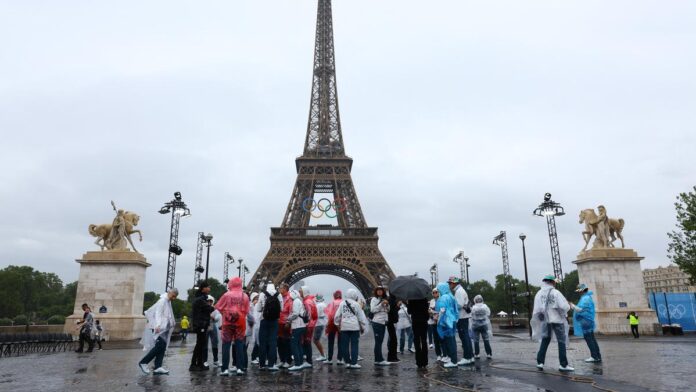
Spectators are seen wearing rain coats near the Eiffel Tower ahead of the opening ceremony of the Paris 2024 Olympics on July 26, 2024.
| Photo Credit: Reuters
With Paris 2024 setting a new benchmark as the most gender-equal Games ever in terms of number, it is time to look back at the long road the modern Olympics has taken in its 128-year-old journey to reach this stage.
When the Games was revived in 1896 at its spiritual home Athens, women’s participation was zero. It was during the first Paris Games in 1900 when 22 women (2.2 per cent out of the 997 participating athletes) were reluctantly allowed to compete for the first time.
Paris again took the lead with a significant number of women participation (the number crossing 100 for the first time, with 125 women out of 3070 athletes) in 1924 and ultimately attained equality after a hundred years.
“Although Paris 1924 was the last edition of the Games at which women were not able to compete in athletics events, their participation in tennis, fencing, swimming, and — albeit less prominently — in other events (sailing and artistic gymnastics) was significant at a time when they were still being firmly rejected by the world of sport,” wrote Thierry Terret, former minister delegate for the Olympic and Paralympic Games Paris 2024, in Olympic Review.
The iconic image of legendary tennis player Helen Wills in all whites, wearing a loose white top, a long skirt, socks up to her knees and a visor cap, lunging forward to play a volley leaves a lasting impression. Athletes like Wills, who not only claimed two gold medals but also won multiple Grand Slam titles later, did a world of good to promote women’s participation in sports in general and in the Olympics in particular.
It has taken more than a century for different sports disciplines, ruled mostly by men, to slowly concede and let female athletes compete.
Although athletics, one of the most anticipated disciplines, permitted women to take part in 1928, it was not until 1984 that the women’s marathon event was added. Three other popular sports — swimming, fencing and gymnastics — started witnessing women athletes from 1912, 1924 and 1928 respectively.
Female athletes began competing in shooting in 1968 before separate women’s events were added in 1984.
Modern pentathlon and weightlifting welcomed the women in 2000, while wrestling had to wait until the following edition.
Boxing, another combat sport, took quite a long — as late as 2012 London Games — to accept women.
The participation of women slowly increased in the post-World War II era and finally crossed 30% (34% to be precise) in the 1996 Atlanta Games. With the International Olympic Committee (IOC) working with International Federations and National Olympic Committees to push for increased participation of women, the percentage has witnessed a steady rise over the last 25 years to reach 48% in Tokyo and even closer to 50% in Paris (out of the projected total figure of 10,500 athletes).
Initiatives such as an increase in the number of medal events for women and introduction of mixed gender events have contributed in making the greater participation of women more meaningful.
Paris 2024 has not only achieved equality in terms of numbers, but has also tried to live its spirit by introducing the mixed team race walking and scheduling the women’s marathon as the last event of the Games instead of the traditionally marquee men’s marathon.

